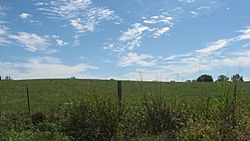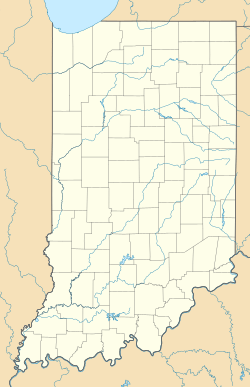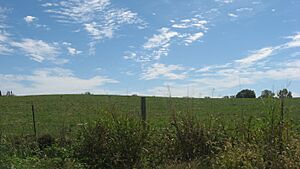Prather Site facts for kids

A field at the site
|
|
| Location | Jeffersonville, Indiana, Clark County, Indiana, |
|---|---|
| Region | Clark County, Indiana |
| Coordinates | 38°22′40.80″N 85°41′41.82″W / 38.3780000°N 85.6949500°W |
| History | |
| Founded | 1000 CE |
| Abandoned | 1180 CE |
| Cultures | Middle Mississippian culture |
| Architecture | |
| Architectural styles | platform mounds, palisade, |
The Prather Site (also known as 12CL4) is an exciting archaeological site in Clark County, Indiana. It was once a major center for the Mississippian culture, an ancient group of people who lived in North America. This site was the most important ceremonial place for a group called the Prather Complex. These people lived in the area near the Falls of the Ohio.
The Prather Site was also close to other ancient groups. These included the Upper Mississippian culture and the Fort Ancient peoples. These groups lived in parts of Southern Indiana, Ohio, and Kentucky.
Contents
Exploring the Prather Site
The Prather Site is located about 3 miles (4.9 km) west of the Ohio River. It sits on a high ridge, not in the low river valley. This is unusual for Mississippian mound centers. However, the site had natural springs and small streams for water.
Other sites in the Prather Complex were also on higher ground. This might mean the people chose these spots for safety. They may have wanted to avoid people traveling on the river. They gave up richer soils near the river for more security.
What the Site Looked Like
The Prather Site was a large village covering about 13 acres (5.2 hectares). It had four large platform mounds. These mounds were arranged in a rectangle around a central open area called a plaza. People likely lived in houses around this plaza.
Scientists believe the largest mound was used from about 1000 to 1180 CE. This means the site was active for nearly 200 years. It's also possible that a palisade (a strong fence of wooden stakes) surrounded the village. This would have helped protect the people living there.
Modern Challenges for the Site
Today, the Prather Site is near Indiana State Road 62. It's also close to a former military plant. This area used to be mostly countryside. But now, new homes and businesses are being built quickly.
New roads and housing projects are planned for the area. These developments could harm the ancient site. Protecting the Prather Site for future study is very important.
Discoveries at Prather Site
Archaeologists have studied the Prather Site many times. They dig carefully to find clues about the past.
Early Digs in the 1930s
In the early 1930s, a man named E.Y. Guernsey explored the site. He worked for Eli Lilly and the Indiana Historical Society. Guernsey found three mounds at the site. He dug into the smallest one and looked at the largest.
He discovered different ways people were buried. Some were in stone box graves. Others were buried under a clay floor. Guernsey also found many interesting artifacts. These included:
- Pottery: Typical Mississippian culture pottery made with crushed shells.
- Discoidal: A stone disc used in a game called chunkey.
- Shell Gorget: A decorative necklace made from a shell.
- Copper Bird: A carved wooden bird covered in thin copper.
Some of these amazing finds are now at the Glenn Black Laboratory of Archaeology at Indiana University-Bloomington. Others are at the University of Michigan Museum of Anthropology.
Later Excavations
After Guernsey, other archaeologists continued to work at the site. In 1971, Donald Janzen led a field school there. He found parts of a wall from a building. This building dated back to about 1045 CE. He also found more Mississippian pottery. Some pieces were plain, while others had special designs.
More recently, in 2003, Cheryl Munson and Robert McCullough led new excavations. Their work was supported by the National Park Service. These ongoing studies help us learn more about the ancient people of the Prather Site.
The Prather Complex
The Prather Complex is a group of related ancient sites. It is the most northeastern group of the Middle Mississippian culture. These sites are all located in the Falls of the Ohio region. This area includes parts of central Kentucky and southern Indiana.
Neighboring Cultures
The Prather Complex was separated from other Mississippian groups. For example, the Angel Phase lived about 53 miles (85 km) southwest. The area between them was an "empty buffer zone." This means no one lived there.
Another empty zone stretched about 59 miles (95 km) northeast. This separated the Prather people from the Fort Ancient culture. These empty zones might have been for social or political reasons. But they also might have been places where the land wasn't good for farming. The Mississippian people relied on growing lots of corn.
The Falls of the Ohio region was special. It had wide, flat floodplains. These areas were perfect for farming. Other similar farming areas were far away, near Cincinnati, Ohio and Evansville, Indiana.
Important Sites in the Complex
The Prather Site was the main ceremonial and political center. But other large sites were also part of the complex. These include Willey, Spangler-Koons, and Newcomb/Elrod/Hale. Smaller sites like Ellingsworth and Clark's Point also belonged to the complex.
Even though Prather was important, some burial rituals happened at other sites. For example, stone box graves were found at Willey and Spangler-Koons. This shows that different sites played different roles in the lives of the Prather Complex people.



